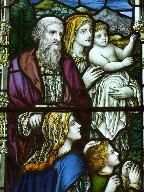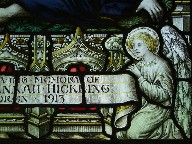| |
|
 |
|
You head south, leaving
behind the tedious miles of Yarmouth and
Lowestoft suburbia, industrialisation and
caravan parks. Or perhaps you are cycling
the narrow lanes around delightfully
remote Henstead and Benacre. Whichever,
to reach this church you must travel for
a while on the awful A12, the main road
connecting London with the east coast.
But shortly, you turn off down a narrow
lane which, before fading out into the
farmyard of Frostenden Hall, takes you
past this little round-towered church on
its mound. Apart from the Hall, there is
no other building in sight, and the
rolling fields and copses go some way to
ameliorating the noise of the traffic on
the road beyond. The tower sits
contentedly, and this church is in no
particular hurry about anything. You
may find sheep grazing in the churchyard,
or watch, as I did one autumn day in
2011, a tractor and plough cleaving a
line away from me towards the top of the
ridge, a rabble of seagulls wafting and
diving behind it. I sat on the wall to
watch because, unusually for this part of
Suffolk, Frostenden church is kept
locked, and I was waiting for the
churchwarden. They open it every Saturday
morning, but this was a Friday afternoon.
There is no keyholder notice, but when I
rang one of the churchwardens he was very
happy to come and open up, even though it
did mean him crossing the busy A12.
|
This
is one of Suffolk's oldest round towers, probably
early Norman but quite possibly Saxon, and the
church against it, although much newer, is still
mainly 13th century. A pretty sundial over the
south door exhorts us in Latin to Watch and Pray.
The porch forms the most westerly bay of the
south aisle, and you step through it past an
elaborate graffito reading 1606 into a
simple, well-kept interior.
I
remembered liking this church a lot on my
previous visit in 1998, though I didn't remember
much about it. It's a quiet place, with nothing
spectacular to impose itself. There is some very
good early 20th century glass, and a fine Arts
and Crafts memorial to a former Rector
contemporary with it. A good earlier memorial to
William Glover came just before the end of the
Commonwealth. The Glovers must have been a
locally significant family, as there are other
memorials to them.
The
font appears to predate its Perpendicular cover
by a century or so, and the cover itself is
smaller around the base than you might expect.
Perhaps it came from a different font originally,
or, as Sam Mortlock thought, it is a cut down
version of a towering font cover of the type
found at Ufford and Hepworth. Turning east, I
like the way the rood loft stairs turn back
westwards from within the chancel. Best of all, I
think I like the slightly uneven pamment floors.
They lend an air of restraint to what is
otherwise undeniably a 19th Century interior.
| Back out in the churchyard,
there is a curiosity. The parish war
memorial sits to the south of the porch.
If you look at the names around the base,
you will see that this parish lost more
men in the Second World War than it did
in the First. This is most unusual - you
come across it in suburbs, where a city
has grown to engulf what had been rural
parishes, but not in remote spots like
this. It seems impossible that Frostenden
had a larger population during the second
war than in the first, so I wonder what
the story behind the discrepancy is? Beyond
the churchyard wall, the ditch marks the
route of the former river that served
this village when it was an early
medieval port. At Domesday, there were
two churches here, and a thriving
community. Now, only the sheep and the
seagulls will keep you company.
|
|
 |
|
|
|

